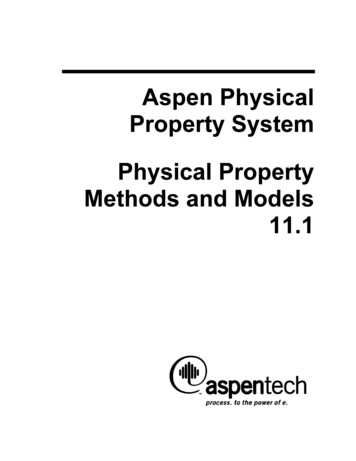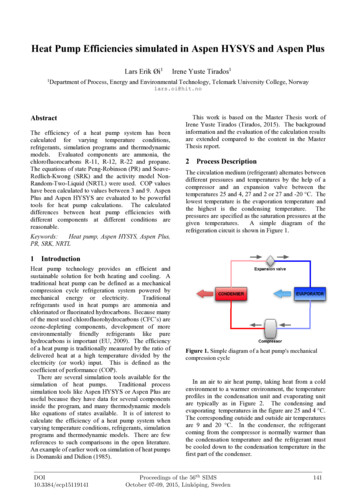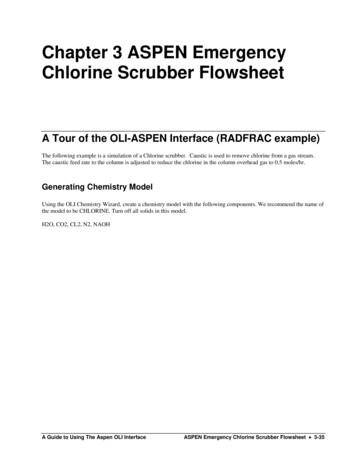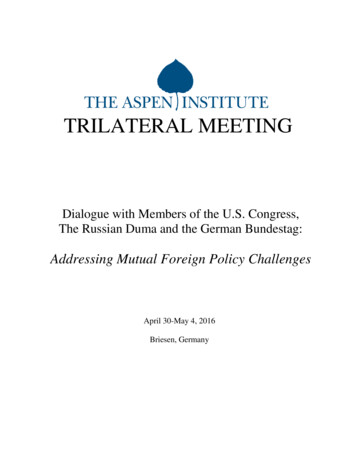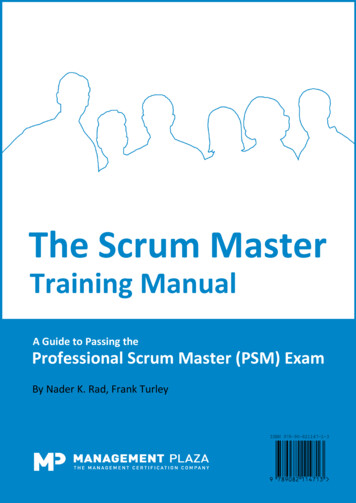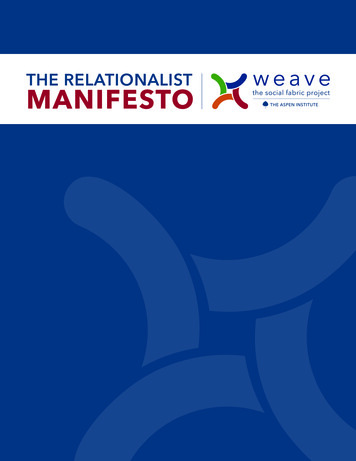
Transcription
THE RELATIONALISTMANIFESTO
WEAVE: THE SOCIAL FABRIC PROJECT BEGAN WITH THE IDEA THAT AMERICA’SSOCIAL FABRIC IS BEING RIPPED TO SHREDS BY DISTRUST, LONELINESS, ALIENATION,INEQUALITY, RACISM, SPIRITUAL EMPTINESS AND TRIBAL ENMITY. BUT WE ALSO KNEWTHAT THERE ARE PEOPLE FIGHTING THESE SCOURGES, SUCCESSFULLY, AT THE LOCALLEVEL ALL ACROSS AMERICA. WE WANTED TO LEARN WHAT THEY COULD TEACH US. WEWANTED TO SHINE A LIGHT ON THEIR EXAMPLES AND MAGNIFY THEIR EFFECT.We traveled the country and found a movementthat doesn’t know it’s a movement. In every city,neighborhood and rural small town, we found scoresof people serving their neighbors and healing bonds.It wasn’t hard to find such people. They are everywhere.The actual work they do is amazingly diverse—some workwith gang members in Chicago, some build gatheringplaces in rural Montana, some work with single momsand malnourished infants in North Carolina. But deepdown it is all the same work. It is building connectionwhere there was no connection, creating relationshipswhere there were no relationships, weaving thickneighborhoods where there were thin neighborhoods.These people aren’t doing their work because theyare interested in making money, or acquiring politicalpower, and they are certainly not interested in fameand celebrity. They are doing their work because theywant to serve their town, unleash the promise in others,ease suffering, live good lives and help create a world inwhich love is plentiful, not scarce.As we spoke with them and got to know them, we kepthearing the same phrases: “serve the whole person,”“radical hospitality,” “deep mutuality,” “asset-basedthinking,” “deep relationality,” “walkout experiences.”Whether it was red America or blue America, wehad same sensation—there are common values here,common actions, common goals. The social fabric isbeing ripped apart by a thousand forces, but theseWeavers are a coherent movement of people trying toknit it back together.But they don’t have many of things most movementshave. They don’t have a common identity, a name,national publications, training academies, core texts oreven an articulated set of principles or creed.The most important thing these people do is their localwork itself. But there is also power in coming togetherto realize: Our work is a part of a large, common work,our efforts are pointed to a common effort. We are one.In 1960, almost nobody called themselves a feminist. By1975 tens of millions of people did. The creation of thatcommon social identity made all the difference.This document is just one piece of the effort to createcohesion and a sense of common identity among themany Weavers across America. It’s not an attempt totell the common story or provide a common symbol orarouse common emotions. This is simply the beginningof an attempt to lay out a common creed. What you areabout to read is the first draft, of what we think of as theWeaver’s creed. It is a rough attempt to articulate theideas behind this movement.It’s important to remember that this is a movement thatexisted in action before it existed in thought. The Weaverswrite their manifestos with the pens of their lives. But welistened to them and observed them and tried to mirrorback a written creed that is implicit in who they are. Wetried to name the core beliefs of this movement, providethe beginnings of coherence and direction. We hopethat if people argue about and discuss this manifestothat will push this movement along, define its animatingprinciples and make this movement contagious.Social movements are not organized top-down anymore.These days they are radically decentralized, and theWeavers are radically decentralized. But there still haveto be hubs—places that help provide coherence, centersof debate, centers of learning, where the common workand the common faith can be hammered out and clearlyarticulated. Weave: The Social Fabric Project hopes tobe one of the hubs, not only with documents like these,but by telling stories, illuminating the work, gatheringfriends and encouraging others to Weave in their ownways, big and small. We hope you’ll read this documentand tell us how to make it better.
THE RELATIONALISTMANIFESTOHYPER-INDIVIDUALISM1. There is always a balance between self and society.In some ages the pressures of the group become stiflingand crush the self, and individuals feel a desperate needto break free and express their individuality. In our age,by contrast, the self is inflated and the collective is weak.We have swung too far in the direction of individualism.The result is a loss of connection—a crisis of solidarity.2. Hyper-individualism, the reigning ethos of ourday, is a system of morals, feelings, ideas, andpractices based on the idea that the journey throughlife is an individual journey, that the goals of life areindividual happiness, authenticity, self-actualization,and self-sufficiency. Hyper-Individualism puts the samequestion on everybody’s lips: What can I do to makemyself happy?3. Hyper-individualism rests upon an emancipationstory. The heroic self breaks free from the stifling chainsof society. The self stands on its own two feet, determinesits own destiny, secures its own individual rights. Hyperindividualism defines freedom as absence from restraint.4. In this way, hyper-individualism graduallyundermines any connection not based on individualchoice—the connections to family, neighborhood, culture,nation, and the common good. Hyper-individualismerodes our obligations and responsibilities to others andour kind.5. The central problems of our day flow from theexcesses of this erosion: social isolation, distrust,polarization, the breakdown of family, the loss ofcommunity, tribalism, rising suicide rates, rising mentalhealth problems, a spiritual crisis caused by a loss ofcommon purpose, the loss—in nation after nation—ofany sense of common solidarity that binds peopleacross difference, the loss of those common stories andcauses that foster community, mutuality, comradeship,and purpose.6. The core flaw of hyper-individualism is that itleads to a degradation and a pulverization of thehuman person. It is a system built upon the egoisticdrives within each of us. These are the self-interesteddrives—the desire to excel; to make a mark in the world;to rise in wealth, power, and status; to win victories andbe better than others. Hyper-individualism does notemphasize and eventually does not even see the otherdrives—the deeper and more elusive motivations thatseek connection, fusion, service, and care. These arenot the desires of the ego, but the longings of the heartand soul: the desire to live in loving interdependencewith others, the yearning to live in service of someideal, the yearning to surrender to a greater good.Hyper-individualism numbs these deepest longings.Eventually, hyper-individualism creates isolated,self-interested monads who sense that something ismissing in their lives but cannot even name what it is.7. Hyper-individualism thrives within the systems ofthe surface. Consumerism amputates what is centralto the person for the sake of material acquisition. Themeritocracy amputates what is deepest for individual“success.” Unbalanced capitalism turns people intoutility-maximizing, speeding workaholics that nopermanent attachment can penetrate.8. The hyper-individualist finds himself enmeshedin a network of conditional love. I am worthy of beingloved only when I have achieved the status or successthe world expects of me. I am worthy of love only whenI can offer the other person something in return. Iam what the world says about me. In the end, hyperindividualism doesn’t make people self-sufficient andsecure. It obliterates emotional and spiritual securityby making everything conditional. It makes peopleextremely sensitive to the judgments of others andquick to take offense when they feel slighted.9. Hyper-individualism directs people toward falseand unsatisfying lives. Some people lead an aestheticlife. They get to taste a series of experiences which maybe pleasant, but which don’t accumulate into anythingbecause they are not serving a large cause. Somepeople become insecure overachievers. They seekto win by accomplishment the love, admiration, andattachment they can’t get any other way, but of courseno amount of achievement ever gives them the lovethey crave.10. When you build a whole society on an overly thinview of human nature, you wind up with a dehumanizedculture in which people are starved of the things theyyearn for most deeply.
11. The uncommitted person is the unrememberedperson. A person who does not live for relation withothers leaves no deep mark on the world.12. Hyper-individualism leads to tribalism.People eventually rebel against the isolation andmeaninglessness of hyper-individualism by joining apartisan tribe. This seems like relation but is actuallyits opposite. If the relationalist mentality is based onmutual affection, the tribalist mentality is based onmutual distrust. It is always us versus them, friend orenemy, destroy or be destroyed. Anger is the mode.The tribalist is seeking connection but isolates himselfever more bitterly within his own resentments anddistrust. Tribalism is the dark twin of community. Thetragic paradox of hyper-individualism is that whatbegan as an ecstatic liberation ends up as individualcrushing war of tribe against tribe.RELATIONALISM1. The revolution will be moral, or it will not be at all.Modern society needs a moral ecology that rejects thereigning hyper-individualism of the moment. We need toarticulate a creed that puts relation, not the individual, atthe center, and which articulates, in clear form, the truthswe all know: that we are formed by relationship, we arenourished by relationship, and we long for relationship.Life is not a solitary journey. It is building a hometogether. It is a process of being formed by attachmentsand then forming attachments in turn. It is a great chainof generations passing down gifts to one another.6. Relationalism is a middle way between hyperindividualism and collectivism. The former detachesthe person from all deep connection. The latterobliterates the person within the group, and seesgroups as faceless herds. The relationalist sees eachperson as a node in a thick and enchanted web of warmcommitments. She seeks to build a neighborhood,nation and world of diverse and creative people whohave made commitments in a flowering of differentways, who are nonetheless bound together by sacredchords.2. The hyper-individualist sees society as a collectionof individuals who contract with one another. Therelationalist sees society as a web of connections that inmany ways that precede choice. A hyper-individualist seesthe individual as an self-sufficient unit; The relationalistsays, A personality is a movement toward others.7. Relationalism is not a system of ideas. It is a wayof life. Relationalism is a viewpoint that draws frommany sources, from Edmund Burke and Martin LutherKing, Jr., from Martin Buber and Dorothy Day and WaltWhitman, from Jacques Maritain, Emmanuel Mounier,Martha Nussbaum, and Annie Dillard to Gandhi andWilliam James.3. As a child, each person’s emotional and spiritualfoundation is formed by the unconditional love of acaring adult. Each person’s attachment style is formedby the dance of interactions between herself and aloving adult. “We” precedes “me.”4. As adults, we measure our lives by the quality ofour relationships and the quality of our service tothose relationships. Life is a qualitative endeavor, nota quantitative one. It’s not how many, but how thick andhow deep. Defining what a quality relationship lookslike is a central task of any moral ecology.5. The best adult life is lived by making commitmentsand staying faithful to those commitments:commitments to a vocation, to a family, to a philosophyor faith, to a community. Adult life is about makingpromises to others, being faithful to those promises.The beautiful life is found in the mutual giving ofunconditional gifts.8. The hyper-individualist operates by astraightforward logic: I make myself strong and I getwhat I want. The relationalist says, Life operates by aninverse logic. I possess only when I give. I lose myselfto find myself. When I surrender to something great,that’s when I am strongest and most powerful.RELATIONALISMIS NOT A SYSTEMOF IDEAS. IT IS AWAY OF LIFE.
THE PROCESS OF BECOMING A PERSON1. The central journey of modern life is moving selfto service. We start out listening to the default settingsof the ego and gradually learn to listen to the highercallings of the heart and soul. Much of modern socialthought, drawing on thinkers such as Machiavelli,Hobbes, and modern economics, sees human beingsas fundamentally selfish. Children, Freud wrote, “arecompletely egoistic; they feel their needs intenselyand strive ruthlessly to satisfy them.” Most of modernthought was written by men, and often a certain sort ofalpha men, who did not even see the systems of carethat undergirded the societies in which they lived.6. But eventually most people realize that somethingis missing in the self-interested life. They achieveworldly success and find it unsatisfying. Or perhapsthey have fallen in love, or been loved in a way thatplows open the crusty topsoil of life and reveals thetrue personality down below. Or perhaps they endure aperiod of failure, suffering, or grief that carves throughthe surface and reveals the vast depths underneath.One way or another, people get introduced to the fulldepths of themselves, the full amplitude of life. Theyrealize that only emotional, moral, and spiritual foodcan provide the nourishment they crave.2. Relationalism asserts that human beings areboth fundamentally broken but also splendidlyendowed. We have egoistic self-interested desires,and we need those desires in order to accomplishsome of the necessary tasks of life: to build an identity,to make a mark on the world, to break away fromparents, to create and to shine. But relationalism assertsthat there are other, deeper parts of ourselves. Thereare motivations that are even stronger than self-interest,even if they are more elusive. At the deepest center ofeach person there is what we call, metaphorically, theheart and soul.7. When a person has undergone one of theseexperiences, which can happen at any age, sheis no longer just an individual; she has become aperson. Her whole personhood is alive and engaged.She has discovered, down at the substrate, her infiniteability to care. Relationalism guides us as we undertakethis personal transformation, surpassing the desires ofthe ego and taking on a bigger journey.3. The heart is that piece of us that longs for fusionwith others. We are not primarily thinking creatures;we are primarily loving and desiring creatures. We aredefined by what we desire. We become what we love.The core question for each of us is, Have we educatedour emotions to love the right things in the right way?4. The soul is the piece of us that gives each personinfinite dignity and worth. Slavery is wrong because itobliterates a soul. Rape is not just an assault on physicalmolecules; it obliterates another soul. The soul yearnsfor goodness. Each human being wants to lead a goodand meaningful life, and feels life falling apart when itseems meaningless.5. A child is born with both ego and heart and soul onfull display. But for many people, around adolescence,the ego begins to swell, and the heart and soul recede.People at this age need to establish an identity, to carvea self. Meanwhile, our society tells adolescent boysto bury their emotions and become men. It tells littlegirls that if they reveal the true depths of themselves,nobody will like them. Our public culture, normalizesselfishness, rationalizes egoism, and covers over andrenders us inarticulate about the deeper longings ofthe heart and soul.8. The movement toward becoming a person isdownward and then outward: To peer deeper intoourselves where we find the yearnings for others,and then outward in relationship toward the world. Aperson achieves self-mastery, Maritain wrote, for thepurpose of self-giving.9. An individual who has become a person has stageda rebellion. She rebels against the individualistic ethosand all the systems of impersonalism. Society tellsher to want independence, but she has declared herinterdependence. Society says we live in a materialistreality, but she says we live in an enchanted reality.Society tells her to keep her options open, but she says,No, I will commit. I will root myself down. Society says,Try to rise above and be better than; she says, No, Iwill walk with, serve, and come in under. Society says,Cultivate with the self-interested side of your life; shesays, No, I will cultivate the whole of myself. Life goeswell only when you are living with the whole of yourself.12. The relationalist doesn’t walk away from thecapitalist meritocracy, the systems of mainstream life.But she balances that worldview with a countervailingethos that supplements, corrects, and ennobles. She walksin that world, with all its pleasures and achievements, butwith a different spirit, a different approach, and differentgoals. She is communal where the world is too individual.She is more emotional when the world is too cognitive.She is moral when the world is too utilitarian.
THE GOOD LIFE1. The relationalist is not trying to dominate lifeby sheer willpower. He is not gripping the steeringwheel and trying to strategize his life. He has madehimself available. He has opened himself up so thathe can hear a call and respond to a summons. He isasking, What is my responsibility here? When a personfinds his high calling in life, it doesn’t feel like he hastaken control; it feels like he has surrendered control.The most creative actions are those made in responseto a summons.his own dependency. A contract gets you benefits, buta commitment transforms who you are.2. The summons often comes in the form of love.A person falls in love with her child, her husband, herneighborhood, her calling, or her God. And with thatlove comes an urge to make promises--to say, I willalways love you. I will always serve you and be there foryou. Life is a vale of promise making.9. The relational life is an open adventure. There arealways ups and down, the forces of impersonalizationwarring against the forces of personalization. Whatmatters is how you serve relationships through the upsand downs. It’s in the how. The profundity is in the adverbs.3. Or a summons may come in the form of a need.There is some injustice, some societal wrong, thatneeds to be fixed. A person assumes responsibility—makes a promise to fight that fight and right that wrong.4. When a summons has been felt and a promisehas been made, a commitment has been sealed. Thelife of a relationalist is defined by its commitments. Thequality and fulfillment of her life will be defined by whatshe commits to and how she fulfills those commitments.5. A commitment is a promise made from love. Acommitment is a promise made without expectingany return (though there will be returns aplenty). Acommitted relationship is a two-way promise. It is youthrowing yourself wholeheartedly for another andanother throwing himself wholeheartedly for you.6. The person makes his commitments maximalcommitments. He doesn’t just have a career; he has avocation. He doesn’t just have a contract marriage (What’sin it for me?). He has a covenantal marriage (I live anddie for you). He doesn’t just have opinions. He submitsto a creed. He doesn’t just live in a place. He helps builda community. Furthermore, he is not just committed tothis abstract notion of “community.” He is committed toa specific community, to a specific person, to a specificcreed—things grounded in particular times and places.7. By committing and living up to the daily obligationsof his commitments, the person integrates himselfinto a coherent whole. Commitments organize thehours and the days of a life. A committed personachieves consistency across time. His character is builtthrough the habitual acts of service to the peoplehe loves. His character is built by being the humblerecipient of other people’s gifts and thus acknowledging8. Relationalists prioritize those actions that deepencommitment, build relation, and enhance humandignity: giving, storytelling, dance, singing, commonprojects, gathering, dining, ritual, deep conversation,common prayer, forgiveness, creating beauty, mutualcomfort in times of sadness and threat, mutual labor forthe common good.10. A committed life involves some common struggles.11. It is, for example, a constant struggle to seepeople at their full depths. In the business of daily lifethere is the constant temptation to see the other personas an object and not a whole. There is the constanttemptation to label and generalize. There is the constanttemptation to reduce people to data and to see them asdata points. You can count apples with data. You can trackhuman behavior in the mass. But there is something thatis unique and irreplaceable about each person that datacannot see. The relationalist tries to see each individualas a whole person—as a body, mind, heart, and soul.12. There is the constant struggle to communicatewell. At every moment there is either a depth ofcommunication or a shallowness of communication.The relationalist seeks conditions that will makecommunication deep and pure. This is hard becausethere’s something in ourselves that eludes our abilityto communicate it. There is something proper aboutmodesty and the slow unveiling of one’s self. Toachieve I–Thou communication, even to glimpse it,the relationalist sits patiently as vulnerabilities aregradually revealed. She offers safety and respect.Sometimes what is deepest is related in the form ofmyth, story, and music. When communication fails or iscorrupted, the French philosopher Emmanuel Mouniersays, I suffer a loss of myself. Madness and misery is aseverance of communication with others.13. There is the constant struggle to live as an effectivegiver and receiver of gifts. There are millions of peoplearound us whose lives are defined by generosity andservice. Personal being, Mounier continues, is essentiallygenerous. But our society does not teach us how to bean effective giver of gifts. The schools don’t emphasize it.The popular culture is confused about it.
14. It is a constant struggle to see life through amoral lens. The practical workaday world primes theutilitarian lens. Consumerism calls forth a self thatis oriented around material pleasure. Money has ananonymous power and tends to render the personon the other side of a transaction invisible. Workplacerivalries and modern politics require armoredindividuals—human tanks with no exposure. The effortto fight the utilitarian lens and see daily life through amoral lens is a hard and never-ending struggle.15. These struggles are not against other people.The line between ego and soul runs down the middleof every person. Most of us, from time to time, buyinto a workaholic ethos that leaves us with little timefor relationship. Most of us, from time to time, hueto a code of privacy that prevents us from actuallyknowing the people who live right nearby. Most of uslive with technology that aims to reduce friction andmaximize efficiency. Relationship, though, is inherentlysticky and inefficient. Most of us, daily, slip back intoself-absorption, succumb to the hunger for status, andhave to recognize that and dive back into relation.16. The relationalist worldview is not about theforces of good conquering the forces of evil. It’salways a competition between partial truths. It’s alwaysan evolving conversation between self and society.It’s always balancing tensions and trying to live life ingraceful balance.17. The relational life is a challenging life butultimately it’s a joyful life, because it is enmeshedin affection and crowned with moral joy.THE GOOD SOCIETY1. As T. S. Eliot observed, the chief illusion of modernpolitical activity is the belief that you can build asystem so perfect that the people in it do not haveto be good. The reality is that democracy and theeconomy rest upon a foundation, which is society. Asociety is a system of relationships. If there is no trustat the foundations of society, if there is no goodness,care, or faithfulness, relationships crumble, and themarket and the state crash to pieces. If there are noshared norms of right and wrong, no sense of commonattachments, then the people in the market and thestate will rip one another to shreds as they vie for powerand money. Society and culture are prior to and moreimportant than politics or the market.2. In this day and age, our primary problems are atthe level of the foundations. They are at the level of thesystem of relationships. Our society has been spiralingto ever-higher levels of distrust, ever-higher levels ofunknowing and alienation. One bad action breedsanother. One escalation of hostility breeds another.3. The call of relationalism is to usher in a socialtransformation by reweaving the fabric of reciprocityand trust, to build a society, as Dorothy Day put it, inwhich it is easier to be good.4. The social fabric is not woven by leaders fromabove. It is woven at every level, through a millioncaring actions, from one person to another. It iswoven by people fulfilling their roles as good friends,neighbors, and citizens.5. Whenever I treat another person as if he werean object, I’ve ripped the social fabric. When I treatanother person as an infinite soul, I have woven thesocial fabric. Whenever I lie, abuse, stereotype, ortraumatize a person, I have ripped the fabric. WheneverI see someone truly, and make them feel known, I havewoven the fabric. Whenever I accuse someone ofcorruption without evidence, I have ripped the socialfabric. Whenever I disagree without maligning motives,I have woven it. The social fabric is created through aninfinity of small moral acts, and it can be destroyed bya series of immoral ones.5. Personal transformation and social transformationhappen simultaneously. When you reach out andbuild community, you nourish yourself.6. The ultimate faith of relationalism is that we areall united at the deepest levels. At the surface wehave our glorious diversity. But at the substrate thereis a commonality that no amount of hostility can everfully extinguish, that no amount of division can everfully sunder.WHEN I TREATANOTHER PERSONAS AN INFINITESOUL, I HAVEWOVEN THESOCIAL FABRIC.
7. Relationships do not scale. They have to be builtone at a time, through patience and forbearance. Butnorms do scale. When people in a community cultivatecaring relationships, and do so repeatedly in a waythat gets communicated to others, then norms areestablished. Trustworthy action is admired; empathyis celebrated. Cruelty is punished and ostracized.Neighborliness becomes the default state. An emergentsystem, a culture, has been created that subtly guidesall the members in certain directions. When you createa norm through the repeated performance of somegood action, you have created a new form of power.People within a moral ecology are given a millionsubtle nudges to either live up to their full dignity orsink to their base cravings. The moral ecology is thething we build together through our daily decisions.8. Rebuilding society is not just get-togetherism—convening people in some intellectually or morallyneutral way. There has to be a shift in moral culture, ashift in the definition of the good life people imaginetogether.9. The state has an important but incomplete roleto play in this process. The state can provide services,but it cannot easily provide care. That is to say, the statecan redistribute money to the poor, can build homelessshelters and day care centers. It can create the materialplatforms on which relationships can be built. But thestate can’t create the intimate relationships that build afully functioning person. That can only happen throughhabitual personal contact. It is only through relationshipsthat we become neighbors, workers, citizens, and friends.A DECLARATION OF INTERDEPENDENCE1. A good society is like a dense jungle. There are vinesand intertwining branches. There are enmeshed rootsystems and connections across the canopy. There aremonkeys playing at the treetops, the butterflies dartingbelow. Every creature has a place in the great ecosystem.There is a gorgeous diversity and beauty and vitality.2. A good person leading a good life is a creatureenmeshed in that jungle. A beautiful life is a plantedlife, attached but dynamic. A good life is a symbioticlife—serving others wholeheartedly and being servedwholeheartedly in return. It is daily acts of loving-kindness,gentleness in reproach, forbearance after insult. It is anadventure of mutual care, building, and exploration. Thecrucial question is not, Who I am? but, Whose am I?3. Most of us get better at living as we go. Therecomes a moment, which may come early or later in life,when you realize what your life is actually about. You lookacross your life and review the moments when you feltmore fully alive, at most your best self. They were usuallymoments when you were working with others in serviceof some ideal. That is the agency moment. That is themoment when you achieve clarity about what you shoulddo and how you should live. That is the moment whenthe ego loses its grip. There is a sudden burst of energythat comes with freedom from the self-centered ego. Lifebecomes more driven and more gift. That is the momentwhen a life comes to a point.4. When you see people at that point, you realize theyhave an interior stronghold of values and devotionsagainst which even the threat of death could notprevail. When you see people at that point, you seea generosity that radiates out into the word. You seepeople giving f themselves, not even in the grand ways,but just in the small favors and thoughtful considerations.This is how
enemy, destroy or be destroyed. Anger is the mode. The tribalist is seeking connection but isolates himself ever more bitterly within his own resentments and distrust. Tribalism is the dark twin of community. The tragic paradox of hyper-individualism is that what began as an ecstatic liberation ends up as individual crushing war of tribe .


